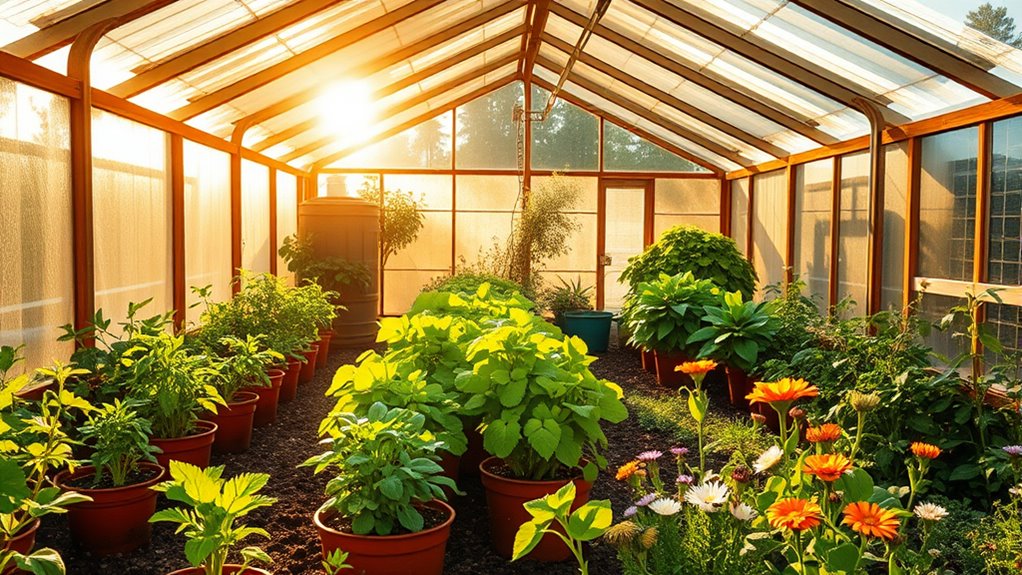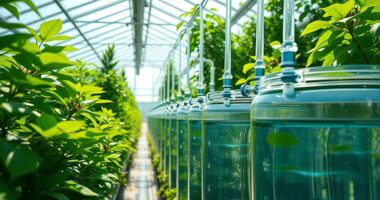To reduce your greenhouse's carbon footprint, embrace renewable energy sources like solar or wind. Enhance energy efficiency by switching to LED lighting and improving insulation. Practice sustainable water management with drip irrigation and rainwater collection. Focus on promoting soil health through composting and conservation tillage, while adopting waste reduction strategies by reusing materials and recycling. Implement climate-smart agricultural practices to ensure a resilient and eco-friendly greenhouse. There's even more you can do to make a difference.
Key Takeaways
- Utilize solar energy systems to power greenhouse operations, reducing reliance on fossil fuels and lowering energy costs.
- Implement energy-efficient technologies like LED lighting and automated controls to minimize energy consumption.
- Adopt sustainable water management practices, such as drip irrigation, to reduce water usage and associated energy costs.
- Enhance soil health through composting and cover cropping, which sequesters carbon and improves plant productivity.
- Incorporate precision farming techniques to optimize resource use, minimize waste, and lower the environmental impact of greenhouse operations.
Embracing Renewable Energy Sources
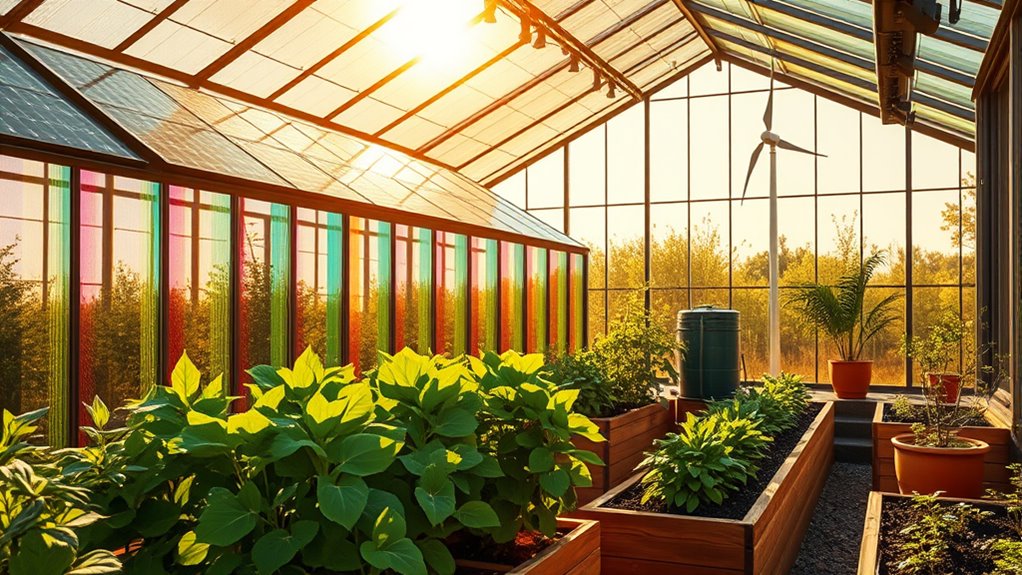
As you look to reduce your greenhouse's carbon footprint, embracing renewable energy sources can be a game-changer.
Solar energy stands out as a clean, renewable option that cuts your reliance on fossil fuels. While the initial investment in solar panels may be high, they can significantly lower your long-term energy costs. Not only can you install them directly on your greenhouse or nearby, but advancements in technology have also made them more affordable and efficient. Additionally, transitioning to renewable energy sources can enhance energy efficiency in greenhouse operations, leading to significant savings on overall energy expenditures. Furthermore, the economic benefits of solar energy include job creation in the manufacturing and installation sectors, contributing to local growth. Moreover, employing systems like heat pumps can reduce energy bills by up to 50%, further supporting your sustainability efforts.
Embrace solar energy to reduce fossil fuel reliance and enjoy long-term savings on your greenhouse's energy costs.
Wind energy is another fantastic choice if you're in a windy area, offering zero-emission electricity.
Biomass energy, derived from organic waste, provides a sustainable and reliable energy source, while geothermal systems efficiently maintain consistent temperatures.
Together, these renewable sources can enhance your greenhouse's sustainability and environmental impact.
Enhancing Energy Efficiency in Greenhouses

Implementing renewable energy sources sets a strong foundation for enhancing energy efficiency in your greenhouse. Start by switching to LED lighting, which saves energy and lasts longer than traditional options. Use light diffusers and reflectors to maximize natural light, cutting down on artificial lighting needs. Automated controls like timers and sensors help you optimize lighting based on environmental conditions, reducing waste. Consider heat pumps and geothermal systems for efficient heating and cooling. Insulate your greenhouse properly to maintain temperature consistency, and use double-glazed windows to minimize heat loss. Lastly, incorporate motion sensors and Energy Star appliances to ensure all equipment operates efficiently. These measures not only save energy but also promote healthier plant growth, while sustainable agricultural practices contribute to lower emissions and enhance the overall environmental impact of your greenhouse.
Implementing Sustainable Water Management Practices
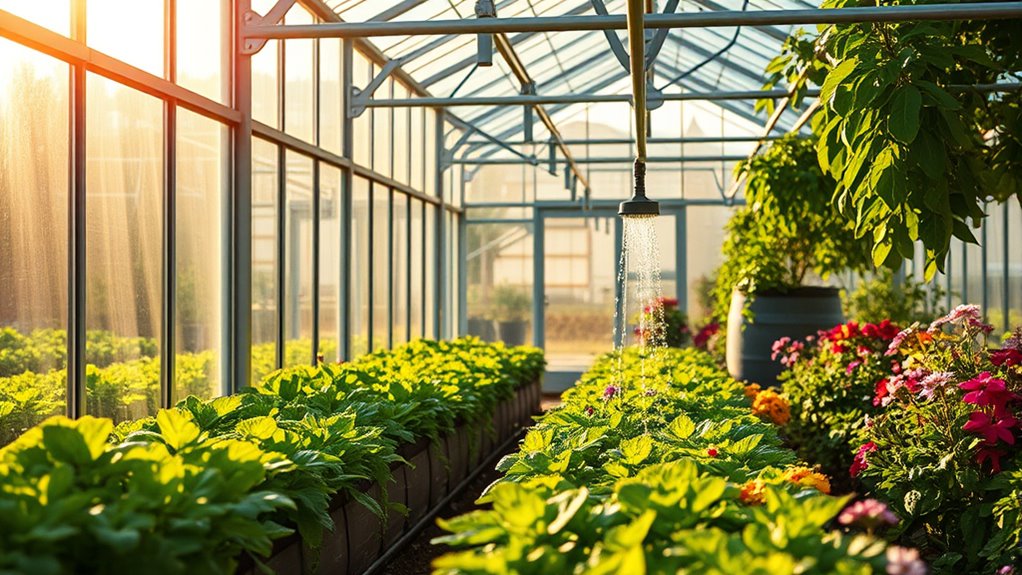
Sustainable water management practices are crucial for reducing your greenhouse's overall environmental impact and ensuring healthy plant growth.
Implementing water-saving technologies like drip irrigation directs water to plant roots, minimizing evaporation. Aeroponics and ebb-and-flow systems further reduce water use, while fogging systems maintain humidity, lowering overall water needs. Reducing water usage is vital not only for conserving resources but also for lowering energy consumption in the long run.
Water-saving technologies like drip irrigation and aeroponics significantly reduce water use while optimizing plant growth and humidity.
Enhance water retention by using superabsorbent polymers, mulching, and cover cropping. Collecting rainwater and recycling greywater are effective ways to utilize alternative water sources.
Optimize your irrigation schedules with soil moisture sensors and climate-based adjustments, ensuring precise water delivery.
Promoting Soil Health and Carbon Sequestration

By increasing soil organic matter through composting and cover cropping, you can boost carbon sequestration while improving crop yields. Incorporating chia seeds into your gardening practices can also enrich the soil and improve its nutrient density, as they are high in omega-3 fatty acids, which can support overall plant health. Additionally, using sustainable gardening techniques can further enhance the ability of your greenhouse to contribute to a healthier environment. Conservation tillage methods, like no-till, help protect stored carbon, minimizing erosion and runoff. Healthy soil can store greater amounts of carbon, which further contributes to reducing overall greenhouse gas emissions.
Rotating crops optimizes nutrient use and further enhances soil health. Healthy soils not only sequester carbon but also improve resilience to climate extremes, ensuring better water retention and reduced irrigation needs.
Adopting Waste Reduction and Recycling Strategies
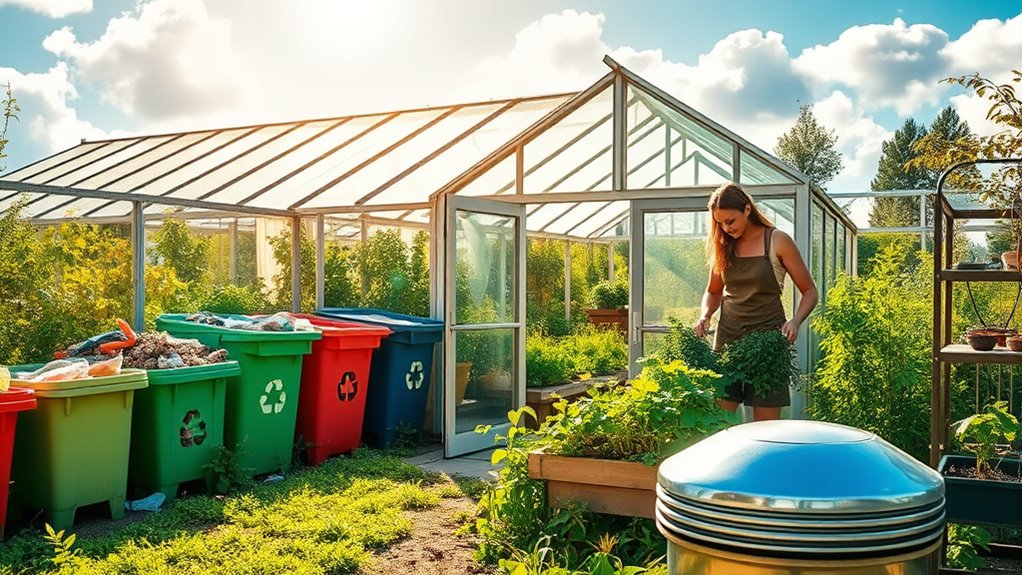
While managing waste might seem daunting, adopting effective reduction and recycling strategies can significantly lower your greenhouse's carbon footprint. Start by reducing material use—choose products made with less material to cut down on energy needed for extraction and processing. Reuse items whenever possible to extend their life and minimize waste. Avoid single-use products to further decrease waste and emissions. Implementing high-impact, low-cost reduction strategies, like designing or selecting sustainable products that incorporate recyclable materials, can enhance your overall impact. Additionally, using backyard greenhouses can help you grow your own food sustainably, further reducing your carbon footprint. Implementing recycling and composting programs can save energy and reduce methane emissions. Moreover, understanding filial responsibility laws can guide families in planning for sustainable practices that benefit both the environment and the community. Additionally, creating public awareness campaigns can boost community participation in these efforts. Furthermore, embracing sustainable practices such as using certified materials can help mitigate the harmful effects of traditional resource extraction.
Utilizing Climate-Smart Agricultural Practices
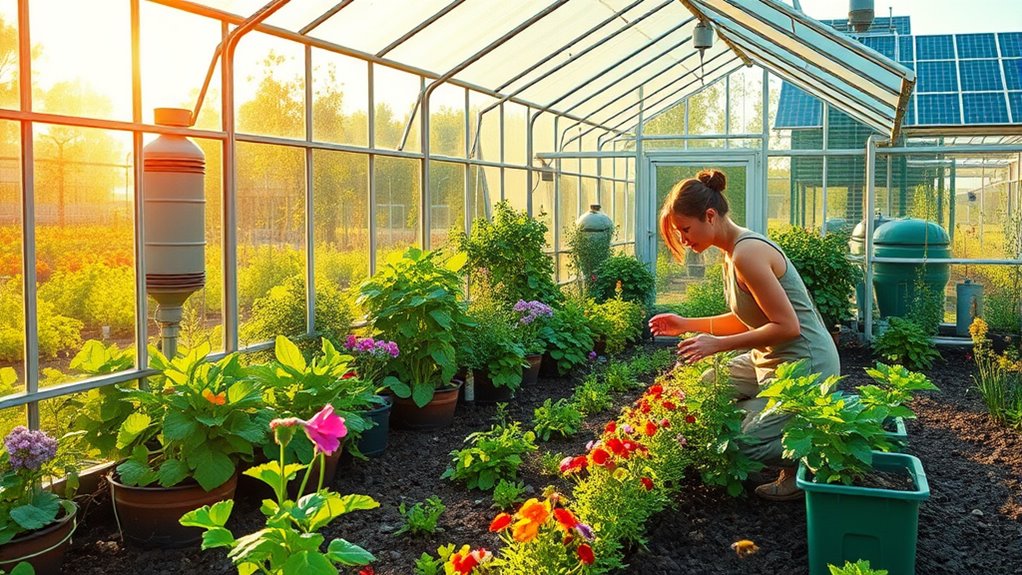
Utilizing climate-smart agricultural practices not only enhances productivity but also significantly reduces your greenhouse's carbon footprint.
By choosing drought-resistant maize or flood-tolerant rice, you ensure stable yields even in extreme weather, supporting food security while minimizing your land use. This is especially important as agriculture accounts for approximately 22% of global greenhouse gas emissions. Additionally, having a solid understanding of emergency preparedness essentials can help you navigate potential agricultural disruptions caused by natural disasters.
Incorporating agroforestry boosts soil fertility and biodiversity, as trees sequester carbon and prevent soil erosion.
Precision farming technologies, like satellite imagery and GPS, allow you to monitor crop health and optimize resource use, reducing waste and environmental impact.
Finally, sustainable livestock management practices, such as rotational grazing and efficient feeding, lower methane emissions and improve soil health.
Together, these practices create a resilient agricultural system that benefits both the environment and your greenhouse's productivity.
Frequently Asked Questions
How Can I Calculate My Greenhouse's Carbon Footprint?
To calculate your greenhouse's carbon footprint, start by identifying your main emission sources, like energy use, transportation, and waste.
Use tools like the EPA's Greenhouse Gas Equivalencies Calculator to estimate your emissions based on these factors.
Track your energy consumption, fuel types, and waste disposal methods to gather accurate data.
Once you've calculated your emissions, you can identify specific areas where you can reduce your carbon footprint effectively.
What Are the Benefits of Organic Farming in Reducing Emissions?
Imagine a garden flourishing under the sun, where every plant thrives in harmony.
By choosing organic farming, you'll not only embrace this lush landscape but also significantly cut emissions. Without synthetic fertilizers, you're reducing nitrous oxide and energy use, creating a healthier ecosystem.
Your soil will store more carbon, promoting biodiversity and resilience. Ultimately, it's a step towards a sustainable future, nourishing both your plants and the planet.
How Does Greenhouse Location Affect Carbon Reduction Strategies?
Your greenhouse location significantly impacts your carbon reduction strategies.
If you're in a colder climate, you'll need to invest in better insulation to minimize heating costs.
Being close to markets reduces transportation emissions, while access to renewable energy sources can lower your reliance on fossil fuels.
Additionally, local incentives for renewable energy can encourage you to adopt greener practices, ultimately making your operations more sustainable and efficient.
Can Companion Planting Help Reduce My Carbon Footprint?
Yes, companion planting can help reduce your carbon footprint.
By strategically pairing plants, you naturally control pests and enhance growth without relying on chemical pesticides. Healthier plants absorb more CO2, while optimized resource use minimizes waste.
Plus, certain combinations improve flavor, reducing the need for external fertilizers.
Embracing biodiversity through companion planting fosters a thriving ecosystem, supporting local wildlife and creating a more sustainable garden that contributes positively to the environment.
What Certifications Are Available for Sustainable Greenhouse Practices?
Imagine your greenhouse shining like a gold medal, proudly displaying sustainable certifications.
You've got options like USDA Organic Certification, which ensures strict organic practices, and GlobalG.A.P., focusing on food safety.
LEAF Marque promotes wildlife conservation, while IFOAM champions biodiversity.
Plus, there's Demeter for those wanting to dive deeper into holistic farming.
These certifications not only boost your market access but also build consumer trust and enhance your greenhouse's environmental impact.
Conclusion
By embracing renewable energy and enhancing efficiency, you can reduce your greenhouse's carbon footprint while promoting a healthier environment. It's not just about growing plants; it's about nurturing the planet. Implementing sustainable practices like water management and soil health can lead to thriving crops and a thriving Earth. As you adopt waste reduction strategies and climate-smart methods, you'll find that every small change makes a big impact. Together, we can cultivate a greener future for generations to come.
